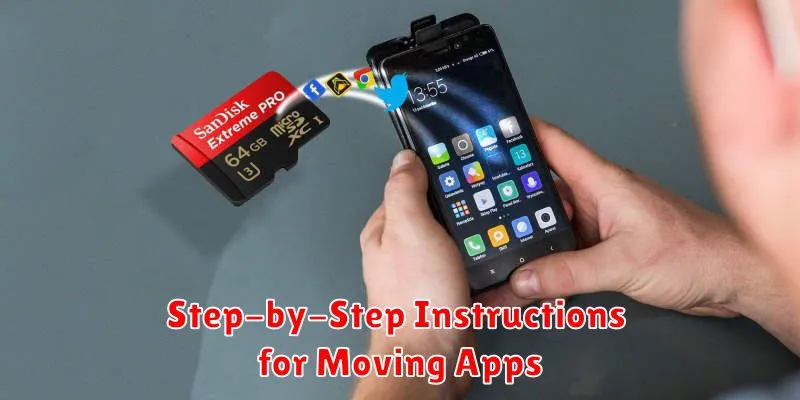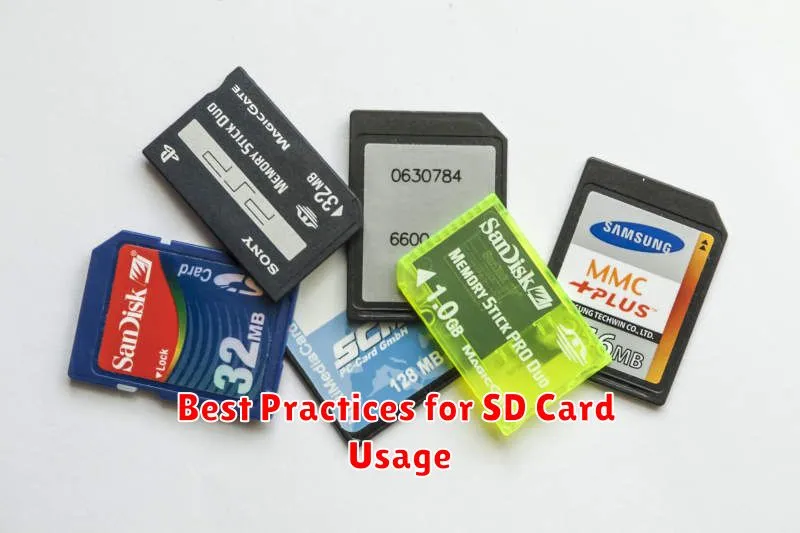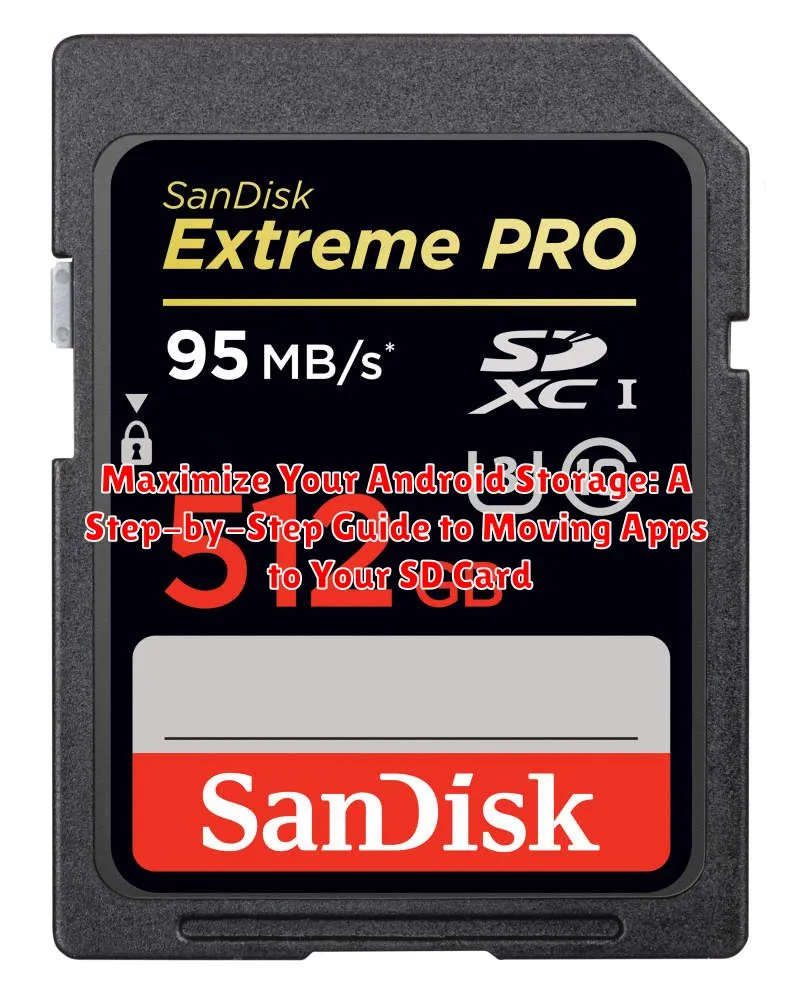Is your Android device constantly reminding you about low storage? Are you tired of deleting precious photos, videos, and apps to make space? You’re not alone. Many Android users struggle with limited internal storage. Fortunately, many Android devices support expandable storage via SD cards. This allows you to maximize your storage capacity and move apps to your SD card, freeing up valuable space on your device’s internal memory. This comprehensive, step-by-step guide will show you how to move apps to SD card on your Android device, regardless of your Android version or device manufacturer. Learn how to effectively manage your Android storage and reclaim control over your device’s performance.
This guide will cover various techniques for moving apps to your SD card. We will explore the native Android methods, discuss the limitations of certain Android versions and manufacturers, and provide potential solutions for devices that don’t directly support this feature. By following these instructions, you can maximize your Android storage, improve device performance, and enjoy a smoother, more efficient Android experience. Say goodbye to low storage warnings and hello to more apps, photos, and videos. Let’s begin!
Why Move Apps to an SD Card?
Running low on internal storage can severely impact your Android device’s performance. Moving apps to an SD card is a practical solution to reclaim valuable space and keep your device running smoothly.
Limited Internal Storage: Many Android devices, especially budget-friendly models, come with limited internal storage. This space fills up quickly with apps, photos, videos, and other files. Transferring apps to your SD card frees up this internal storage.
Improved Performance: A full internal storage can lead to sluggish performance. Moving less frequently used apps to the SD card can free up resources and improve overall device responsiveness.
Accommodating Large Apps and Games: Modern apps, particularly games, can consume significant storage space. An SD card provides a secondary storage location for these larger apps, allowing you to install and enjoy them without constantly worrying about storage limitations.
Checking SD Card Compatibility
Before attempting to move apps, it’s crucial to verify if your Android device and SD card support this functionality. Not all Android versions or devices allow app transfers to SD cards.
Device Compatibility: Some manufacturers disable the option to move apps to external storage. Check your device’s documentation or settings to confirm if this feature is available.
Android Version: Older Android versions (prior to Android 6.0 Marshmallow) generally supported app transfers more readily. Newer versions may have limitations or require the SD card to be formatted as internal storage, which affects how the card functions overall.
SD Card Format: Your SD card may be formatted as portable storage or internal storage. Check its current format in your device’s storage settings. Portable storage allows you to transfer media files, while internal storage allows apps to be moved. The format affects how the system interacts with the card.
App Compatibility: Not all apps can be moved to an SD card. Some app developers restrict this functionality. You will discover app compatibility during the moving process itself, as those restricted will not offer the option to move.
Preparing Your SD Card for App Transfer
Before transferring apps, ensure your SD card is properly formatted and ready. This process will erase all data on the SD card, so back up any important files beforehand.
Formatting Your SD Card
Android typically offers two formatting options for SD cards: portable storage and internal storage.
Portable Storage: Choose this if you want to use the SD card to store media files (photos, videos, music) and some app data. It allows you to easily remove the card and access its contents on other devices.
Internal Storage: Selecting this option formats the SD card as an extension of your device’s internal storage. It allows you to move more apps to the SD card. However, formatting it this way makes the card encrypted and unusable on other devices.
Consult your device’s documentation for specific instructions on how to format your SD card. Generally, it can be found within the storage settings.
Step-by-Step Instructions for Moving Apps

The process for moving apps to your SD card can vary slightly depending on your Android version and device manufacturer. However, the general steps remain similar.
Using Device Settings (for compatible apps):
- Open your device’s Settings app.
- Navigate to Apps or Application Manager (the wording may differ).
- Select the app you wish to move.
- Look for a Storage or Storage Used option.
- If the app supports moving to the SD card, you’ll see a button labeled “Change” next to the storage location. Tap it.
- Select your SD card from the available storage options.
- The system will then begin transferring the app. This process may take a few moments.
Troubleshooting Common Issues
While moving apps to an SD card is usually straightforward, you might encounter some issues. This section addresses common problems and provides solutions.
App Not Movable
Some apps are designed by developers to be installed only on internal storage and cannot be moved. This is often due to security or performance reasons. In this case, no workaround exists.
Insufficient SD Card Space
If your SD card doesn’t have enough free space, you won’t be able to move apps. Check your SD card’s available storage and delete unnecessary files or consider using a larger capacity card.
Corrupted SD Card
A corrupted SD card can prevent apps from transferring or functioning properly. Try reformatting your SD card, but remember this will erase all data on it. Backing up important files beforehand is crucial.
App Malfunctions After Transfer
If an app doesn’t work correctly after being moved, try clearing the app’s cache and data, or reinstalling it. If the problem persists, the app may not be compatible with running from the SD card.
Managing Apps on Your SD Card
Once you’ve moved apps to your SD card, managing them effectively is crucial for optimal performance and storage organization. This involves understanding how to view moved apps, move them back to internal storage if needed, and handle app updates.
Viewing Moved Apps
Most Android devices provide a way to view which apps are currently installed on the SD card. This is typically found within the Settings app under Apps or Application Manager. Look for an option to filter or sort apps by storage location.
Moving Apps Back to Internal Storage
If you encounter performance issues or an app requires installation on internal storage, you can easily move it back. The process is similar to moving it to the SD card initially, generally accessible through the app’s info page within the Settings menu.
Handling App Updates
By default, app updates usually download to the same location as the original app. Therefore, if your app resides on the SD card, its updates will also install there. However, some apps may require installation on internal storage even if the previous version was on the SD card. Pay attention to any prompts during the update process.
Best Practices for SD Card Usage

To ensure optimal performance and longevity of your SD card, follow these best practices:
Choosing the Right Card
Invest in a high-speed SD card with a suitable storage capacity. Class 10 (or higher) is recommended for smoother app performance. Consider A1 or A2 rated cards if you plan to install many apps.
Safe Removal
Always safely eject your SD card before physically removing it from your device. This prevents data corruption and potential app issues. Look for the “eject” option in your device’s storage settings.
Regular Formatting
Periodically format your SD card to maintain its performance. Formatting erases all data, so back up any important files beforehand.
Storage Awareness
Be mindful of the storage space available on your SD card. Avoid filling it to maximum capacity, as this can impact performance.

